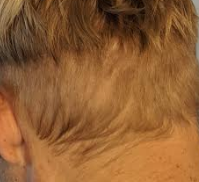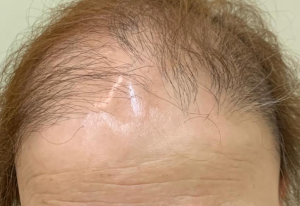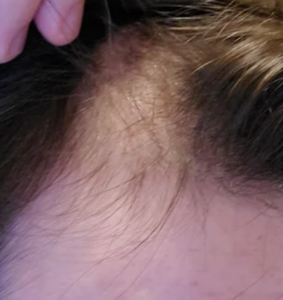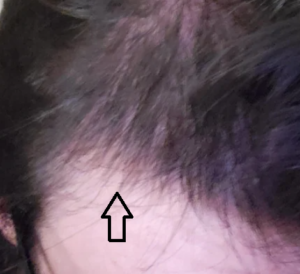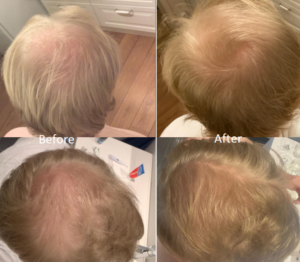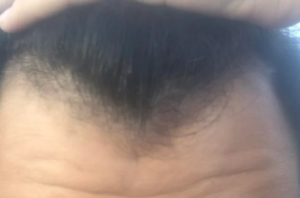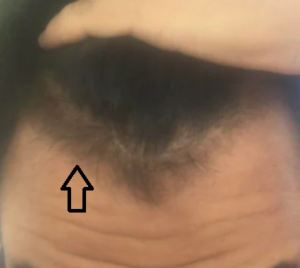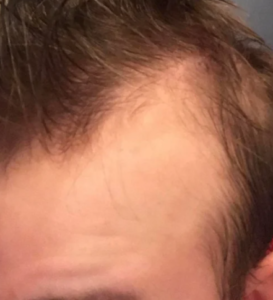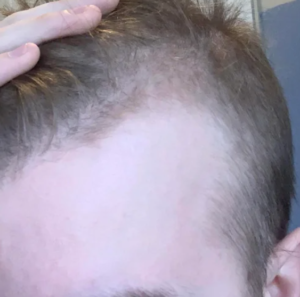If the person has never had diffuse hair loss (like me). I suspect if it was in my genes, the so-called “diffuse thinning”, I would already have it and as you can see my head is full of hair, I’m merely a “receeder” not a “diffuse thinner”, Could the forehead reduction surgery ON ITS OWN cause diffuse hair loss?
As a general rule, I believe that forehead advancement surgery in men puts them at risk of balding and showing the scarring and making it look unnatural if that should happen. IF a man had a Bill Clinton hairline or a Ronald Reagan hairline, and they were over 45 with a normal HAIRCHECK test, I would not have a problem with a hairline advancement surgery on them.
I perform HAIRCHECK tests on most patients who want to start finasteride because I want to be able to follow their progress and if the drug is halting or reversing the hair loss., The HAIRCHECK test gives me a metric which allows me and the patient to know with reasonable certainty what is happening to them and with my experience I can often predict long-term hair loss patterns allowing my patients to build a Master Plan for future planning both for financial reasons and for hair growth reasons. If the HAIRCHECK shows no balding, I don’t prescribe finasteride. Also if a patient is depressed and I feel that there will be a link between finasteride and his depression, I might not prescribe it. My assessment of the patient is always one-on-one and then I have the priveledge to prescribe it or not.
In addition, I take a careful history, get to know the patient and try to understand their sexual history and if they may be good a candidate or not go good candidate for this drug. I have turned people down based upon these discussions.
No it is not too early as you are now 25 and your pattern should be generally known by now. The corners are easy to transplant and the area behind the middle frontal hairline is thinning from the photo view. The entire area can be transplanted easily with FUE, about 1300 grafts might do it. You should take finasteride to prevent shock loss and the advancement of the loss process especially if you get it transplanted.
It has been a rollercoaster with finasteride: I first used 5 months of topical Morr-F, which at first I saw real results after just a month or 2, but after that my hair seemed to get worse again. It got really bad when in April I started oral fin and used minoxidil instead of the Morr-F, but at around June my hair had become significantly worse. I am a Nw2.5-3 with diffuss forelock, but initially saw vellus hairs fill in the temples. It could have been that not all the morr f was legitimate, I don’t know. The strange thing was that around last month I thought I finally began to see results: the vellus hairs came back and the forelock was slightly thicker it seemed, but since a few weeks it has all gone again and it is significantly thinner again.
I am very confused guys. My hair is in a terrible state in the front (at or below baseline) so am I just unlucky or should I wait even longer? It gets me quite depressed. No side effects though on fin (except abdominal fat gain since starting oral, no change in diet).
Finasteride isn’t for everyone. In some men it just doesn’t work. See a hair expert MD for how to manage your hair.
Some men believe that hard exercise increases testosterone and thereby increases hair loss. That is not the case.
Is the long term use of corticoisteroids possible? It has helped with my itching and light burning on my scalp and I would like to continue using it as it reduces shedding.
I am also exploring the idea of corticoisteroid injections as my dermatologist had offered it.
I have been on fin for 1 month already.
Steroids will induce hair loss if it is prolonged and you have the genes for hair loss.
I’d strongly caution you against looking at mpb based on level of testosterone or even DHT. Mpb is a result of complex biological interactions and exercise results in complex effects on the body. Exercise association to Mpb need not have any relationship to whether or not exercise affects testosterone.
https://www.ncbi.nlm.nih.gov/pmc/articles/PMC5500728/ This was published just over 2 years ago to look at the association of AGA and exercise. They got somewhat mixed results and fail to properly control for the effects of balding on degree of exercise, but nonetheless among those with a family history of AGA it does suggest at least some association of having AGA and engaging in more exercise than those without AGA. The association may be severely reduced in those without a predisposition for AGA as shown in the no family history of AGA. (Fig. 1) Which could suggest some interaction of exercise to AGA among people predisposed to AGA that is not present it those who are not predisposed to AGA.
There aren’t really worthwhile studies to answer the question since the few that exist fail to remove the issue of degree of balding affecting degree of exercise. It would probably be worthwhile to make a well designed questionnaire which effectively addresses this question, since previous studies have all been poorly designed in that regard such that we have no real evidence to answer the question of this post for causation.
Good study; however, it was only the low intensity exercise group with a family history of AGA that saw an effect causing alopecia. The study was taken with participant cooperation and therefore required individual reporting, which has its limits. Thanks for following up and pointing me to this interesting study.
The problem is that when you get a hair transplant and the donor hair has been used, it reduces forever, the amount of donor hair that you have as your donor area is limited. This can’t be reversed so when a hair transplant fails, not only are you deformed where you received the hair transplants, but you are depleted of valuable donor hair. Make sure that the next doctor is experienced and has a GREAT reputation and hopefully that doctor can make something good happen for you. You can go back to your original doctor and ask for your money back.
Page 3 of 6


